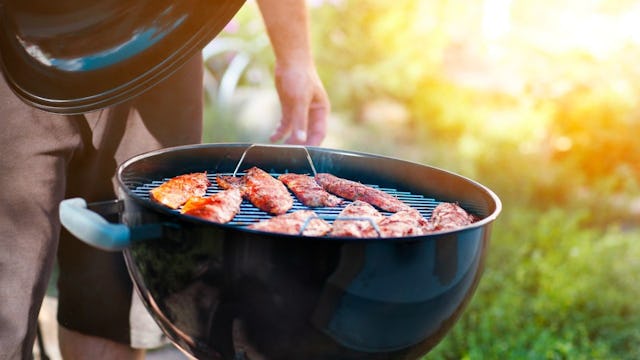That Time I Was Poisoned At A BBQ

I was poisoned by the same toxin that may have felled a Russian whistleblower.
Since one of our guests was highly allergic to fish, I marinated and thoroughly cooked the fish in my cast iron skillet in the kitchen instead of on the grill that my husband manned outside. I was hungry and had eaten about half of the fish—maybe four ounces of the larger of the two fillets my girlfriend had dropped off after her husband’s very successful fishing expedition—before my husband finished grilling. I offered some of the smaller fillets to my young daughter and the wife of our allergic friend. Each had a small bite, but professed a preference for the hot dogs and burgers.
RELATED: Food Poisoning or the Stomach Flu? How to Tell and Treat
Fifteen minutes later, the meat had just come off the grill when I sat down with the remains of my plate of tuna and an ear of corn.
A wave of heat swept over me—I’m a redhead and, therefore, have become accustomed to all manner of flushing and blushing these past forty years. I once had a coach who pulled me out of games when I reached what he referred to as “peak crimson.” But this was different. It felt like my skin was on fire.
My heart was racing. I took a few deep breaths. My head throbbed and a fight or flight feeling came over me.
My husband looked at me across the table, sunglasses lowered. “Are you okay?” he asked. “You’re red as … I’ve never seen you that particular color.”
My friends concurred.
“Actually, no,” I said.
I went into the kitchen followed by my husband and two concerned friends. “Is it an allergic reaction?” the friend with the fish allergy asked. “Do you have Benadryl?”
“Right, right. Benadryl. Can’t hurt,” I mumbled, digging into the medicine cabinet and popping in 25 mg.
“Maybe another?” my husband suggested, eyeing me. “And then the hospital?”
Our friends nodded.
I took another capsule.
“Hospital? Is it really that bad?” I said.
“Um, your eyes are completely bloodshot,” my husband said. “And your skin seems to be passing red on its way to purple.”
Our friends departed and my husband drove me to the hospital.
“That’s a really bad sunburn,” the triage person said.
“It’s not sunburn,” I replied. “I haven’t been out in the sun more than an hour today—and I always wear sunscreen.”
They took my history and vitals. My pulse was rapid and my normally low blood pressure was at hypertensive levels.
“One of the medications you’re taking increases sun sensitivity,” the nurse practitioner told me.
“I know, I’ve been on and off it for five years. I’m very careful.”
The emergency room was remarkably quiet, and I was whisked back to a room. Ten minutes later the physician came in. I relayed my symptoms: sudden onset of severe flushing 15 minutes after eating the fish, headache, agitated, and—a new one since arriving at the hospital—diarrhea.
“You have scombroid poisoning,” he said, without missing a beat. He went on to explain that he sees it once or twice a year in his emergency room. Usually, it’s in people, like me, who have eaten fish not commercially caught and processed. Scombroid fish poisoning, also known as histamine fish poisoning, is an allergic-type reaction that occurs when certain types of fish are not properly refrigerated (due to an interruption in the cold chain, a temperature controlled supply chain).
Bacteria in the fish can multiply, break down the flesh of the fish, and produce high amounts of histamine. It doesn’t matter if the fish is cooked thoroughly or eaten raw, because the histamine is not affected by heat. The most common culprits are finfish such as tuna, mackerel, amberjack, and bonito, but fish like mahi mahi, bluefish, marlin, and escolar can also cause scombroid poisoning.
While severe reactions like mine are not common, there may be many more unreported cases from people with milder reactions or those who do not seek medical care. Neither my friend nor my daughter had a reaction to the small amount they ate. The doctor said it could’ve been theirs was uncontaminated (they did have a different piece) or they may have been less susceptible for a variety of reasons.
According to poison control, the most common symptoms of scombroid fish poisoning are rash, diarrhea, reddening or flushing of the face and upper part of the body, sweating, headache, and vomiting. Some experience a burning sensation or swelling of the mouth, difficulty swallowing, stomach cramping. Heart palpitations may also occur.
The doc gave me intravenous medications, observed me for a bit to be sure the flushing was diminishing, and the blood pressure was coming down, and sent me home with instructions to keep up the Benadryl until feeling better.
I eat poke or sushi once a week. I love the stuff. While I won’t ever trust fish caught by a friend again, this incident has given me new appreciation for the people in the fishing, trucking, seafood processing, and grocery/restaurant industries, and how hard they work to maintain that cold chain. I plan to renew my sushi-love at the first opportunity.
This article was originally published on